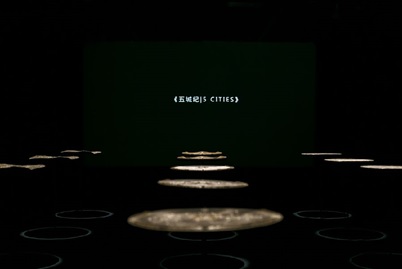New Exhibition Opens: 5 CITIES
07/31/2016
On July 30, the “5 Cities” exhibition, sponsored by Qian Xuesen Library & Museum of Shanghai Jiao Tong University, undertaken by the 5 Cities Planning Team, and co-organized by the Urbanspace Planning & Architectural Design Group (Shenzhen), was unveiled in Qian Xuesen Library & Museum. The exhibition was jointly planned by the young curator Wu Junyi and architect Wang Zhuoer. It’s the first time for both alumnae of Shanghai Jiao Tong University to honor their alma mater on its 120th anniversary by means of an exhibition.

Zhang Kai, Executive Director of Qian Xuesen Library & Museum, delivered an inaugural address. This exhibition is a fresh try in various ways: exhibition collaboration, academic support and exhibit promotion. The exhibition themed in architecture coincides with Qian Xuesen’s academic thinking about architectural science and scenic cities.
“5 Cities” consisted of 25 round metal spraying models and 1 short video, which presented a game about cities. 25 models were floating in the all-black space, showing five distinct visual city prospects. Every city was divided into five form elements including terrain, facilities, landscape, architecture and public space, reflecting diversified social status.
Wang Zhuoer,the curator and young architect, said, “Observing the urban morphology is the most direct way to understand a society. In areas of deep industrialization, every part of the city is closely and orderly connected. A healthy society which puts inhabitants the first has constrained urban areas, but the vegetation coverage is generally unlimited. However, more commercialized cities would be full of high-rise buildings. It’s meaningless to talk about cities with no regard of a society. City design mostly depends on rulemaking, while rulemaking comes from people.”
“Chinese cities have developed rapidly over the past decades, but the rapid advancement has caused short-sighted and disordered urban planning. As an architect, how to clarify our thinking and build a macro perspective becomes the most critical issue when we are confronted with super-huge and fragmented cities. When we created the exhibition, my team simplified the cities into only five elements . Starting from scratch, young architects built their own ideal cities on the empty ground like our ancestors.”
In addition to model exhibits, a short video was also presented in the exhibition. The video explored the relationship between real cities and visual cities by organically combining city scenes from over 30 films and games. Wu Junyi, the other curator, insisted that films and games not only reappeared in real space, but also created a visual space. City shots in films turned viewers into urban “surveyors” and “stragglers”.
The curators expressed that “5 Cities” was of real significance for architectural designers and common audiences. “Models can partly help architects get rid of real rules and systems, break away from restrictions, as well as rethink the essence of cities. For non-professionals, exhibition and virtual cities in the video presented diversified cities, expanded visions, and established basic awareness of cities.”
